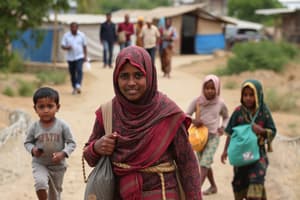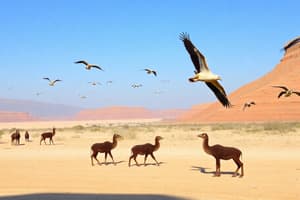Podcast
Questions and Answers
What does MEDC stand for?
What does MEDC stand for?
What is the primary difference between push and pull factors in migration?
What is the primary difference between push and pull factors in migration?
What defines a megacity?
What defines a megacity?
What is urbanisation?
What is urbanisation?
Signup and view all the answers
During which centuries did the Renaissance occur?
During which centuries did the Renaissance occur?
Signup and view all the answers
What was a defining characteristic of city-states in Renaissance Italy?
What was a defining characteristic of city-states in Renaissance Italy?
Signup and view all the answers
What are some challenges associated with living in megacities?
What are some challenges associated with living in megacities?
Signup and view all the answers
What was the primary cause for the beginning of the Renaissance in Italy?
What was the primary cause for the beginning of the Renaissance in Italy?
Signup and view all the answers
What was a significant focus of art and architecture during the Renaissance?
What was a significant focus of art and architecture during the Renaissance?
Signup and view all the answers
Which invention played a key role in spreading knowledge during the Renaissance?
Which invention played a key role in spreading knowledge during the Renaissance?
Signup and view all the answers
During the Renaissance, which scientific theory proposed that the sun was at the center of the universe?
During the Renaissance, which scientific theory proposed that the sun was at the center of the universe?
Signup and view all the answers
In Shogunate Japan, who held the real power in governance?
In Shogunate Japan, who held the real power in governance?
Signup and view all the answers
What was the primary purpose of the Sakoku policy in Japan?
What was the primary purpose of the Sakoku policy in Japan?
Signup and view all the answers
Which class in Japanese feudal society primarily served as warriors?
Which class in Japanese feudal society primarily served as warriors?
Signup and view all the answers
What was one of the main aims of humanism during the Renaissance?
What was one of the main aims of humanism during the Renaissance?
Signup and view all the answers
Which of the following was NOT a factor contributing to Japan's period of isolation?
Which of the following was NOT a factor contributing to Japan's period of isolation?
Signup and view all the answers
Which change did Japan undergo during the Meiji Restoration?
Which change did Japan undergo during the Meiji Restoration?
Signup and view all the answers
What was a key characteristic of Shintoism?
What was a key characteristic of Shintoism?
Signup and view all the answers
Flashcards
MEDC
MEDC
More Economically Developed Country; a country with a high level of wealth and development.
LEDC
LEDC
Less Economically Developed Country; a country with a lower level of wealth and development.
Megacity
Megacity
A city with over 10 million people.
Renaissance
Renaissance
Signup and view all the flashcards
Push Factors
Push Factors
Signup and view all the flashcards
Pull Factors
Pull Factors
Signup and view all the flashcards
Urbanization
Urbanization
Signup and view all the flashcards
City-State
City-State
Signup and view all the flashcards
Renaissance art key themes
Renaissance art key themes
Signup and view all the flashcards
Printing press significance
Printing press significance
Signup and view all the flashcards
Renaissance inventions
Renaissance inventions
Signup and view all the flashcards
Humanism's core focus
Humanism's core focus
Signup and view all the flashcards
Shogunate Japan social structure
Shogunate Japan social structure
Signup and view all the flashcards
Shogun's role
Shogun's role
Signup and view all the flashcards
Samurai code
Samurai code
Signup and view all the flashcards
Japanese isolation
Japanese isolation
Signup and view all the flashcards
Meiji Restoration impact
Meiji Restoration impact
Signup and view all the flashcards
Renaissance impact
Renaissance impact
Signup and view all the flashcards
Study Notes
Changing Nations
-
MEDC and LEDC: More Economically Developed Countries (MEDCs) and Less Economically Developed Countries (LEDCs) represent different levels of economic development and wealth.
-
Push and Pull Factors: Push factors motivate people to leave a place (e.g., war, lack of jobs), while pull factors attract them to a new one (e.g., better education, safety).
-
Migration Reasons: People migrate for various reasons, including better jobs, escaping danger, or joining family.
-
Demographic Data: Death rate—deaths per 1,000 people; Birth rate—births per 1,000 people; Mortality rate—deaths by age or cause; Demographics—population data (age, gender, etc.).
-
City Life Advantages and Disadvantages: Cities offer jobs, education, and entertainment but face problems like pollution, traffic, and overcrowding.
-
Megacities: Cities with over 10 million people (e.g., Tokyo, New York, Mumbai).
-
Megacity Challenges and Opportunities: Megacities provide numerous jobs and services but often struggle with housing shortages, pollution, and transportation.
-
Urbanization: The growth of cities as people move there for opportunities, leading to challenges like slums, traffic, and environmental damage.
Renaissance
-
Renaissance Definition: A period of significant cultural, artistic, and scientific change in Europe (14th-17th centuries), meaning "rebirth."
-
Renaissance Beginnings: Started in Italy due to wealthy city-states, trade, and rediscovery of ancient texts.
-
Italian Geography: Fertile plains, rivers, and coastal cities fostered trade and culture.
-
City-States: Independent areas governed by a city (e.g., Florence, Venice).
-
Renaissance Social Structure: Divided into nobles, merchants, tradespeople, and peasants.
-
Medici Family: Wealthy bankers who supported arts, science, and politics in Florence.
-
Renaissance Art and Architecture: Focused on humanism, realism, and classical styles; included themes of human emotions, religion, and nature; key artists were Leonardo da Vinci (Mona Lisa) and Michelangelo (David). Key innovations included perspective techniques, oil paints and realistic depictions of anatomy.
-
Printing Press: Revolutionized knowledge and idea sharing by quickly producing books.
-
Renaissance Inventions: Included the telescope, microscope, and mechanical clock.
-
Humanism: Emphasized human potential, learning, and achievements, aiming to improve society and celebrate individuals.
-
Renaissance Scientific and Medical Developments: Included the discovery of blood circulation (Harvey) and the heliocentric model (Copernicus).
-
Renaissance Spread: Spread across Europe to France, England, and Germany.
-
Renaissance Legacy: Significantly influenced modern science, art, and ideas about human rights and learning.
Shogunate Japan
-
Japan's Geography: Primarily an island nation with mountainous terrain, limited farmland, and surrounded by the Pacific Ocean.
-
Feudalism in Japan: A land-based system where land exchange was for loyalty and military service.
-
Japanese Social Structure: Emperor (figurehead), Shogun (military ruler), Daimyo (landlords), Samurai (warriors), farmers, artisans, and merchants; each with specific roles and responsibilities.
-
Emperor's Role: A symbolic figurehead with perceived divine authority.
-
Shogun's Role: The actual military ruler with governing power.
-
Samurai's Role: Warriors following the bushido code, serving their daimyo.
-
Women's Role: Limited rights and primarily focused on family and domestic duties, although some held leadership roles.
-
Shintoism: Focused on nature spirits, rituals, and harmony with the natural environment.
-
Buddhism: Emphasized meditation, reincarnation, and escaping suffering through enlightenment.
-
Shintoism vs. Buddhism: Both emphasized peace and rituals, but Shintoism focused on nature spirits and Buddhism emphasized individual spiritual development.
-
Warring States Period: A chaotic period of conflict among Daimyo before Japan's unification.
-
Unifiers of Japan: Oda Nobunaga, Toyotomi Hideyoshi, and Tokugawa Ieyasu unified Japan, overcoming this period.
-
Oda Nobunaga, Hideyoshi, and Ieyasu's Rise and Fall: Nobunaga started unification but met betrayal; Hideyoshi continued unification but had no effective heir, and Ieyasu completed unification and established the Tokugawa Shogunate.
-
Japan's Isolation: The Sakoku policy led to isolation to limit outside influence and control trade.
-
Meiji Restoration: The modernization of Japan's government, economy, and military to match Western powers.
-
Meiji Restoration Reforms: Included a new constitution, industrialization, education expansion, and technological adoption.
Studying That Suits You
Use AI to generate personalized quizzes and flashcards to suit your learning preferences.
Description
Explore the dynamics of More Economically Developed Countries (MEDCs) and Less Economically Developed Countries (LEDCs). This quiz covers migration factors, demographic data, and the advantages and disadvantages of city life, along with the challenges of megacities. Test your knowledge on the socio-economic changes around the world!




